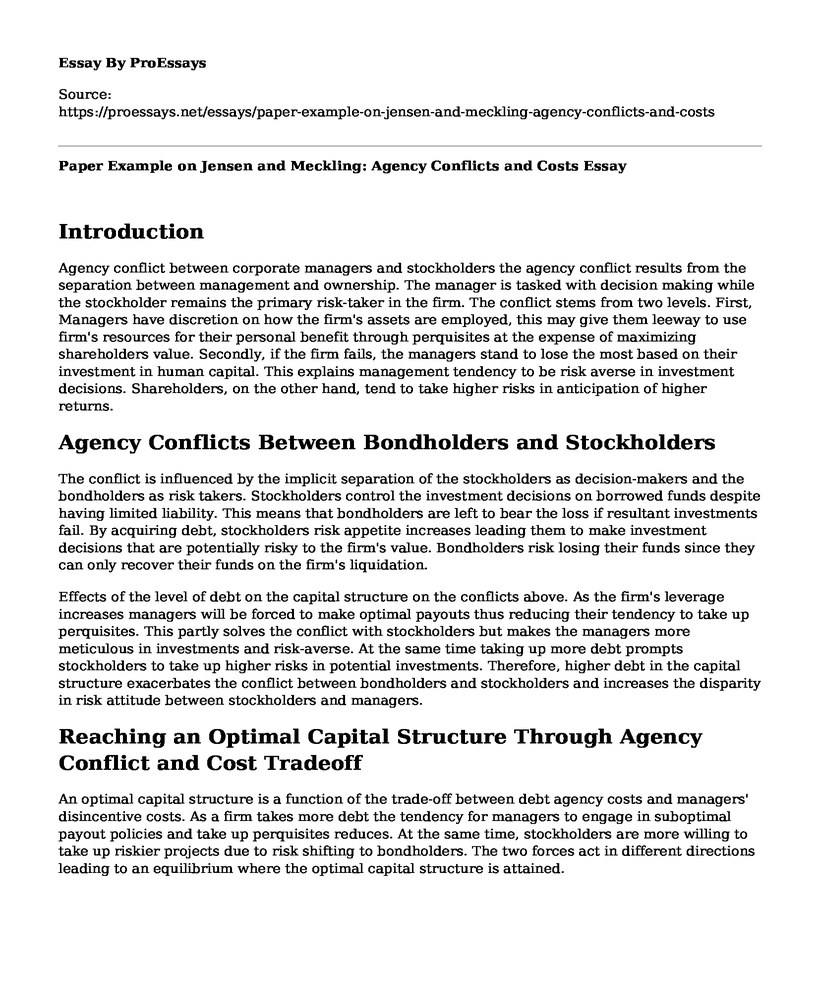Introduction
Agency conflict between corporate managers and stockholders the agency conflict results from the separation between management and ownership. The manager is tasked with decision making while the stockholder remains the primary risk-taker in the firm. The conflict stems from two levels. First, Managers have discretion on how the firm's assets are employed, this may give them leeway to use firm's resources for their personal benefit through perquisites at the expense of maximizing shareholders value. Secondly, if the firm fails, the managers stand to lose the most based on their investment in human capital. This explains management tendency to be risk averse in investment decisions. Shareholders, on the other hand, tend to take higher risks in anticipation of higher returns.
Agency Conflicts Between Bondholders and Stockholders
The conflict is influenced by the implicit separation of the stockholders as decision-makers and the bondholders as risk takers. Stockholders control the investment decisions on borrowed funds despite having limited liability. This means that bondholders are left to bear the loss if resultant investments fail. By acquiring debt, stockholders risk appetite increases leading them to make investment decisions that are potentially risky to the firm's value. Bondholders risk losing their funds since they can only recover their funds on the firm's liquidation.
Effects of the level of debt on the capital structure on the conflicts above. As the firm's leverage increases managers will be forced to make optimal payouts thus reducing their tendency to take up perquisites. This partly solves the conflict with stockholders but makes the managers more meticulous in investments and risk-averse. At the same time taking up more debt prompts stockholders to take up higher risks in potential investments. Therefore, higher debt in the capital structure exacerbates the conflict between bondholders and stockholders and increases the disparity in risk attitude between stockholders and managers.
Reaching an Optimal Capital Structure Through Agency Conflict and Cost Tradeoff
An optimal capital structure is a function of the trade-off between debt agency costs and managers' disincentive costs. As a firm takes more debt the tendency for managers to engage in suboptimal payout policies and take up perquisites reduces. At the same time, stockholders are more willing to take up riskier projects due to risk shifting to bondholders. The two forces act in different directions leading to an equilibrium where the optimal capital structure is attained.
Types of Firms and Levels of Debt
According to Jensen, firms should only take up higher levels of debt at their maturity stage. He argues that taking up debt would force managers to make payouts as opposed to engaging in unprofitable projects or taking up perquisites. In addition, a mature firms' assets are tangibly making it easier draw up debt covenants and control stockholder-bondholder conflict. Growing firms tend to plough back earnings as opposed to making payouts, they also pose higher risks to lenders as such, they should, therefore, employ lower levels of debt.
Types of Bond Covenants
Bond covenants restrict stockholders from making decisions that could lead lenders to lose their funds. The first type is covenants that restrict the issuance of new debt. They protect current debt in a firm from potential debt that could either have an equal or superior claim on a firm's charged assets. The second type: dividend covenants, restrict stockholders from making large payouts to themselves using assets meant for debt repayment (Smith, and Warner). Both types of covenants ameliorate stockholder-bondholder conflict by ensuring that the firm is in a position to adequately cover its interest and principal payments.
Works Cited
Smith Jr, Clifford W., and Jerold B. Warner. "On financial contracting: An analysis of bond covenants." Journal of financial economics 7.2 (1979): 117-161.
Cite this page
Paper Example on Jensen and Meckling: Agency Conflicts and Costs. (2022, Apr 12). Retrieved from https://proessays.net/essays/paper-example-on-jensen-and-meckling-agency-conflicts-and-costs
If you are the original author of this essay and no longer wish to have it published on the ProEssays website, please click below to request its removal:
- Contingency Planning and Risk Analysis of IKEA's Move to Adopt Energy Efficient LED Light Bulbs
- Operations Management Job Essay
- Purpose in Nursing Leadership Paper Example
- Paper Example on TAM's Growth: From $1M to $25M in 2009 Under Jack's Management
- WWII Axis Powers: 3 Leadership Styles Analyzed - Essay Sample
- Essay Example on UTI in SCI: Risks and Prevention
- Blue Ocean Strategy: Create Uncontested Markets and Avoid Competition - Essay Sample







